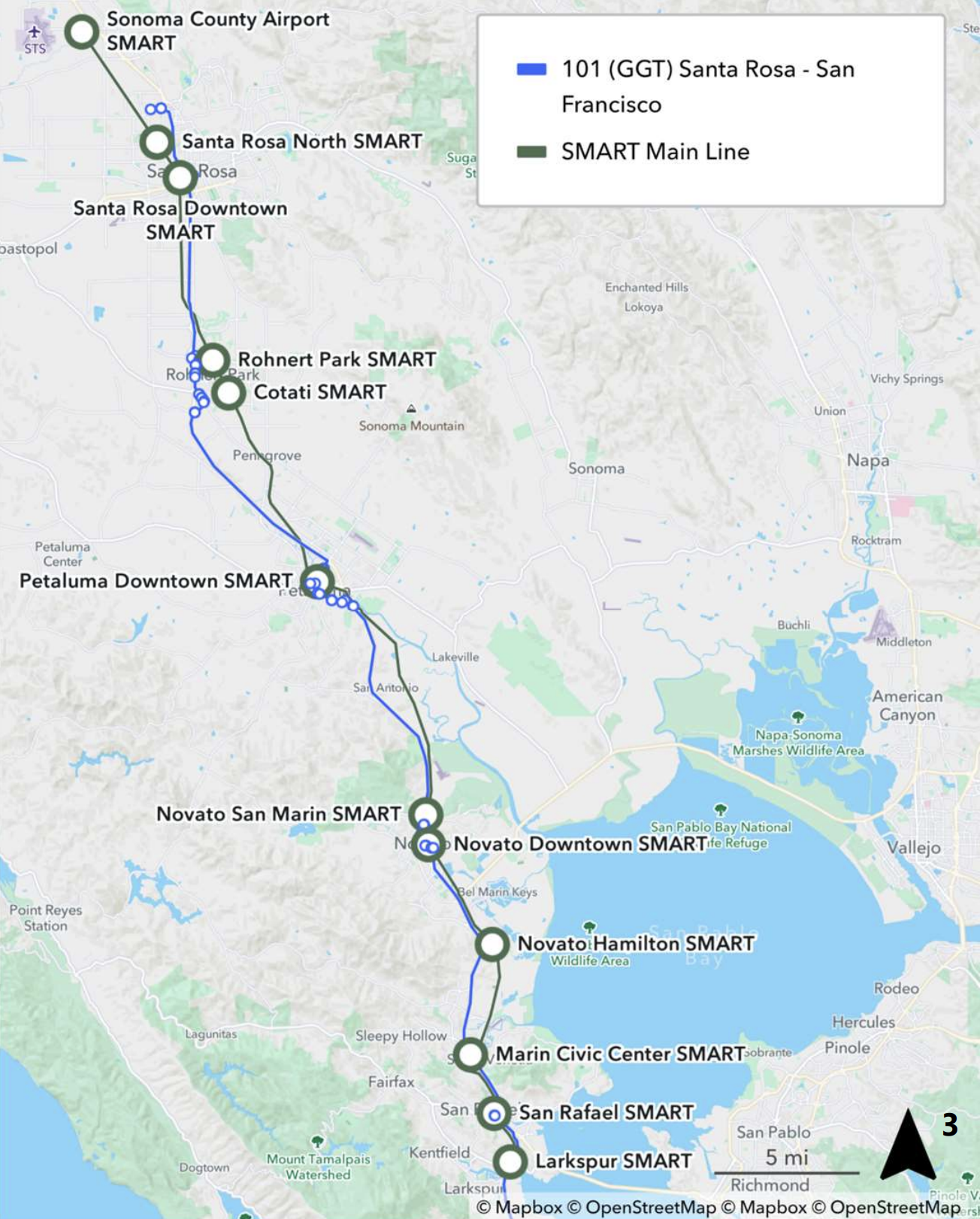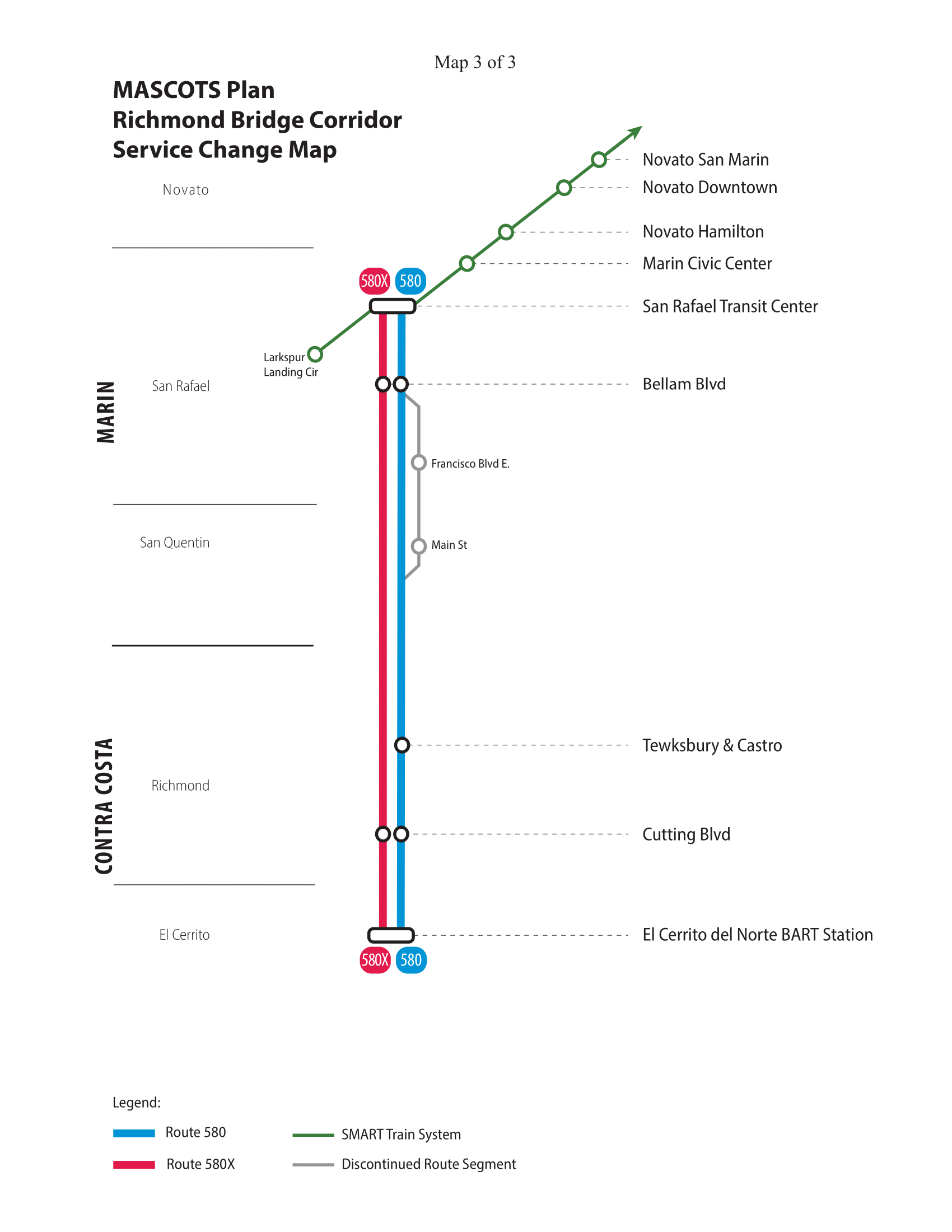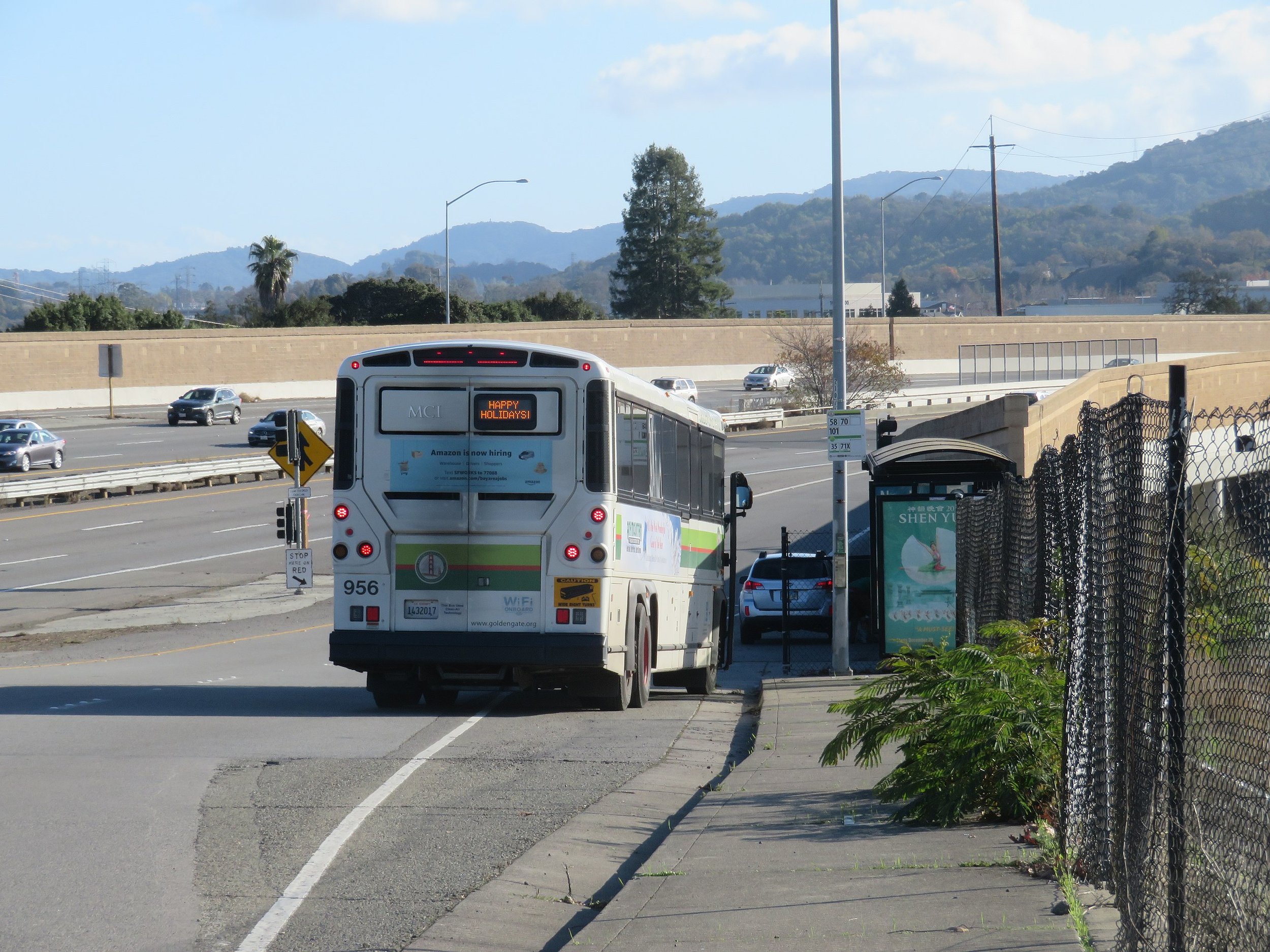North Bay Transit Coordination Plan Aims to Streamline Service
The new plan to streamline transit service in Marin and Sonoma counties is published. The MASCOTS Plan, which the Seamless Blog previously covered in December, aims to increase ridership 8-15% by restructuring North Bay transit service. The plan calls for increasing SMART rail frequency and a reorganization of bus routes, while using only a modest increase in funding.
MASCOTS was developed by nine transit operators and transportation agencies: SMART, Golden Gate Transit, Marin Transit, Sonoma County Transit, Petaluma Transit, Santa Rosa CityBus, the Transportation Authority of Marin, and Sonoma County Transportation and Climate Authorities, and the regional Metropolitan Transportation Commission. The changes are proposed to be implemented as a three-year pilot, to be evaluated after two years.
Proposed Changes
More frequent SMART service replaces GGT Route 101 in Sonoma County
Analysis led by consultant Nelson\Nygaard found that the SMART train, which began service in 2017, has become the most popular north-south service, while ridership on Golden Gate Transit (GGT) buses on Highway 101, which serve the same corridor, has declined. 70% of trips into San Francisco (of all modes) start in San Rafael or further south, the consultant noted.
The MASCOTS plan proposes to increase SMART service and end Golden Gate Transit Route 101 service north of Novato. SMART service would increase by 20% on weekdays and by 50% on weekends, and trains would operate earlier and later in the day all week. Revenues are to be reallocated, primarily within Sonoma County, to support the SMART service increase during the 3-year MASCOTS pilot.
Freed from the need to serve separate infrequent north-south routes run by SMART and Golden Gate Transit, local bus agencies Santa Rosa CityBus, Sonoma County Transit, Petaluma Transit, and Marin Transit would improve their connections to SMART stations. The specific local route changes have not yet been published.
Consolidated commuter bus service
In Sonoma County, peak-hour commute service would be streamlined. GGT Routes 164, 172, and 172X would all become Route 172, providing more frequent service on a single alignment.
GGT Route 101 frequency increased from San Francisco to San Rafael
From San Rafael Transit Center near the south end of SMART, Golden Gate Transit 101 express bus frequency would double to every 30 minutes. Riders going south of San Rafael from Sonoma County would take SMART and transfer at San Rafael.
Golden Gate Transit would also discontinue service on Route 150, which currently stops at highway bus pads in Marin on its way to San Rafael. It cites low ridership and the opportunity to reinvest the service hours in other routes.
MTC has allocated $800,000 in regional funds to support Golden Gate Transit’s implementation of MASCOTS.
Consolidated service on Hwy 101 in Marin
Under the MASCOTS plan, GGT Route 150 will be discontinued. GGT Route 130 service to San Rafael and Marin City will be discontinued, but service between Marin City, Sausalito, and San Francisco will see improved 30 minute frequencies all day.
Faster Richmond-San Rafael Bridge service
GGT Route 580 buses, from San Rafael Transit Center to El Cerrito del Norte BART, would no longer serve local stops in East San Rafael and instead follow the 580X express route within San Rafael. “The local street running in East San Rafael on Route 580 is time consuming and generates very few riders, creating a time penalty for regional travelers who are mostly traveling between BART or the City of Richmond and San Rafael Transit Center,” as stated in a staff report to the Golden Gate Transit Board of Directors. Planners say this would affect about 12 riders per day, who would continue to have service on Marin Transit route 23.
Additionally, more 580 buses would stop in Point Richmond off-peak, when planners say the time penalty for serving the area is low.
Fares
The changes are expected to improve affordability for riders, even with the increase in transfers.
Taking SMART to San Rafael and then Golden Gate Transit will be less expensive than the current fare to ride Golden Gate Transit from Sonoma County, due to the train’s considerably lower fares.
Additionally, when MTC’s interagency transfer pilot is launched (pending completion of Clipper 2.0), and if it is made permanent via passage of the 2026 regional transit measure, fares for multi-agency trips will be further reduced.
Trade-Offs and Concerns
Late-night regional service would be eliminated in Sonoma County
While SMART would be extended two hours later as part of the MASCOTS plan (from 8pm to 10pm), it would not run as late as Route 101 currently does (last San Rafael northbound departure 12:25am). For Sonoma County residents returning home after 10pm, “There are no public transportation options. Passengers would need to use a ride-share service or a private taxi service,” according to MTC.
Although late-night ridership is low, preserving late-night service is essential for Sonoma County residents who work late night shifts, may be travelling back from late night fun in SF or the East Bay, or many other needs. Planners should consider adding two runs of late night “owl” bus service to major SMART stations to preserve this safety net.
Transfers with SMART could have long waits
Although the 30-minute Golden Gate Transit 101 frequency south of San Rafael would improve service to San Francisco, SMART currently operates at 32-, 64-, or 96-minute headways, which it is limited to by single-track segments. As a result, the wait time for a transfer between SMART and Golden Gate Transit at San Rafael Transit Center will vary over the course of a day.
MASCOTS relies on convenient and consistent transfers at San Rafael Transit Center. However, it is also important for Golden Gate Transit to remain on a 30-minute “clockface” schedule, so that buses arrive at a predictable time and can make timed connections with local routes. Planners should therefore find a near-term solution to improve SMART to 30-minute headways, such as by reducing service at Novato San Marin station, which would speed up trains through the single-track area.
Highway bus pads in Marin County would see reduced direct service to San Francisco
In Marin County, direct bus service from Central Marin to San Francisco would no longer be provided outside of commute hours. Golden Gate Transit cited low ridership as the reason behind this service cut. As a result, Larkspur, Corte Madera, and Mill Valley riders would need to make a transfer in Marin City.
For the medium term, planners should also consider infrastructure investments that would facilitate direct transfers between local and highway buses in Marin County. For example, bus-on-shoulder lanes, not currently planned for this segment, could allow highway buses to make more stops at shoulder bus pads without delay. Additional bus pads at Manzanita Park and Ride and Marin City would allow buses to pick up passengers there without deviating from the highway.
However, Marin County’s current shoulder bus pads have low ridership due to their locations far from key destinations and unpleasant waiting experience. An improved version of Route 150, Central Marin’s direct bus connection to San Francisco, could run on city streets rather than bus pass, preserving this key link.
Bus Pad used by GGT Route 101
Paratransit coverage effects have not been shared
Federal law requires on-call paratransit service be provided for persons with disabilities within ¾ mile of fixed-route bus and rail transit. Therefore, any time a transit agency’s coverage changes, paratransit coverage could change as well. The material released for MASCOTS so far has not mapped any changes to paratransit service coverage. Planners should publish this map, and consider voluntarily continuing paratransit service in any areas that would lose mandatory coverage.
Bus bridges should be pre-planned for unexpected SMART outages
With SMART taking a greater share of north-south transit in Sonoma County, it will be even more important for there to be pre-planned bus bridges ready to implement during SMART service disruptions. Planners should confirm these plans are being updated, and modify mutual aid agreements as needed to ensure swift bus bridge implementation.
Opportunities for Input
Survey
The MASCOTS Summer 2025 Survey runs until August 22nd.
Public Meetings
August 18th, 4-5:30pm: Santa Rosa Community Open House (in person)
August 20th, 12pm: Community Meeting (virtual)
August 20th, 5pm: Community Meeting (virtual)
August 21st, 9am: Golden Gate Transit Public Hearing
September: Marin Transit Public Hearing
Fall 2025: Agency Boards finalize changes
Spring 2026: Implement changes as three-year pilot
Email - info@mascotsplan.org
Opportunities for Greater Seamlessness
It is encouraging that so many agencies have been able to collaborate toward improving ridership and system legibility from an operator-neutral planning perspective.
However, the need to preserve late night service along the 101 corridor in Sonoma County, improve SMART service to run at regular 30- or 60- minute intervals for well-time transfers, prevent reductions to the existing paratransit service area, and plan for alternative bus service during SMART service disruptions will be vital to shielding riders from potential negative impacts from changes.
Another longstanding, institutional challenge North Bay transit faces is the fragmentation of transit systems. Each of the six transit agencies have their own public engagement and approval processes and funding sources. Additionally, the lack of cohesive branding, information sharing, or a unified website for North Bay transit makes inter-agency transfers difficult for riders. For a truly great transit experience in the North Bay even more systematic coordination of planning, funding, and service will be beneficial in the long run.
Odin Palen is a transit and cycling advocate in Marin County, Marcus Navarra is a member of the North Bay Transit Riders, and Infrastructure Week is a a bike and transit rider who posts about safe street design and transit projects.





